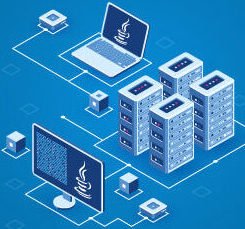
Top 6 Programming Languages for Web Development in 2024: A Comprehensive Guide
Introduction:
Future coders and web wizards! Are you ready to travel into the digital world but find yourself tangled in the web of programming languages? Fear not! We’re here to untangle that web and shine a light on the top 6 programming languages for web development in 2024.
Whether you’re a student or newly graduate just stepping into the vast universe of coding or a curious mind eager to explore, this guide is your golden ticket to understanding the essentials of Java Full Stack, Python Full Stack, TypeScript, PHP, Ruby, and the undeniable basics of HTML & CSS. Get ready to embark on a journey through the languages that are shaping the future of the internet, one line of code at a time.
Java Full Stack - The Evergreen Giant
Java, the evergreen giant of programming languages, continues to stand tall in the world of web development. Renowned for its versatility, Java is the backbone of countless web applications, from small-scale projects to large enterprise systems. The beauty of Java lies in its “write once, run anywhere” (WORA) capability, making it a favourite among full-stack developers who juggle both front-end and back-end development tasks.
Java’s ecosystem is vast, with a multitude of frameworks and tools such as Spring Boot for back-end services, and Angular or React when paired with Java for the front-end, offering a seamless full-stack development experience. For students & graduates, Java serves as an excellent foundation. Learning java full stack developer courses from a reputed institute can helps in developing skills.
Python Full Stack - The Rising Star
Python has rapidly ascended the ranks to become the go-to language for developers seeking simplicity without sacrificing power. Its syntax is clean and readable, making it exceptionally beginner-friendly. Python shines in web development through frameworks like Django and Flask, which allow for the creation of robust web applications with minimal code.
Full-stack development with Python means you can handle everything from database operations to server-side logic and even dip your toes into front-end development with integrations like React or Vue.js. Python’s versatility extends beyond web development to fields like data analysis, machine learning, and AI, making it a valuable language to learn and master.
TypeScript - The Front-End Powerhouse
TypeScript, a superset of JavaScript, brings static typing to the dynamic world of web development. It’s designed to make code more understandable and to catch errors early in the development process, making it a favourite for large-scale and complex applications. TypeScript compiles to JavaScript, ensuring compatibility with any browser, host, or OS.
Adopting TypeScript for front-end development, especially when used with frameworks like Angular, React, or Vue.js, enhances code quality and developer productivity. For students, TypeScript offers a gentle introduction to types and interfaces, concepts crucial for software development, while still being close to JavaScript, the language of the web.
PHP - The Web's Workhorse
PHP, a language specifically designed for the web, powers a significant portion of the internet. Despite mixed opinions in the developer community, PHP’s ease of use, especially for server-side scripting, and its integration with HTML make it a solid choice for beginners and professionals alike. Frameworks like Laravel and Symfony have modernised PHP development, offering elegant syntax and powerful features for building everything from small websites to comprehensive web applications.
For students, PHP offers a direct path to web development, with a low barrier to entry and a vast community for support. It’s a language that teaches the fundamentals of web programming, with immediate results visible in web browsers.
Ruby - The Developer's Delight
Ruby, particularly with its Rails framework (Ruby on Rails), is celebrated for getting web applications up and running quickly. Ruby’s philosophy of “Convention over Configuration” and its elegant, expressive syntax make web development a joy. Ruby on Rails provides a structured approach to web development, with built-in features for common tasks, allowing developers to focus on unique application logic rather than boilerplate code.
Ruby is particularly appealing for students due to its emphasis on good coding practices and its supportive community. The language and framework together offer a comprehensive introduction to web development concepts, making the learning process both educational and enjoyable.
HTML & CSS: The Foundation
No list of web development languages would be complete without mentioning HTML & CSS. These foundational technologies are not programming languages per se but are essential for creating and styling web pages. Understanding HTML (the structure of web pages) and CSS (the styling of web pages) is important for any web developer, serving as the building blocks upon which all web applications are built.
On the flip side, CSS takes this structure and transforms it into something visually appealing. It controls the layout, colours, fonts, and even animations on a webpage, allowing developers to create unique and engaging user experiences. What’s fascinating about CSS is its ability to adapt web designs to different devices and screen sizes through responsive design principles. This ensures that a website can look great and function well, whether it’s viewed on a desktop, a tablet, or a smartphone.
Together, HTML and CSS empower developers to bring their digital visions to life, from simple informational pages to complex web applications. Mastering these foundational technologies is like learning the alphabet before writing stories; they form the basis for all web development projects, making them indispensable tools in a developer’s toolkit.
Conclusion: Your Path to Web Mastery
On the journey of programming language for web development is an exciting adventure filled with endless learning opportunities. Whether you’re drawn to the robustness of Java and Python, the modern capabilities of TypeScript, the practicality of PHP, or the elegance of Ruby, each language offers unique advantages and challenges. HTML & CSS form the bedrock of web development, ensuring that your creations look good and function well across all devices.
As you look into these languages, remember, the best language to learn is the one that aligns with your project needs, learning style, and career aspirations. The world of web development is vast and varied—there’s room for everyone. Happy coding!




